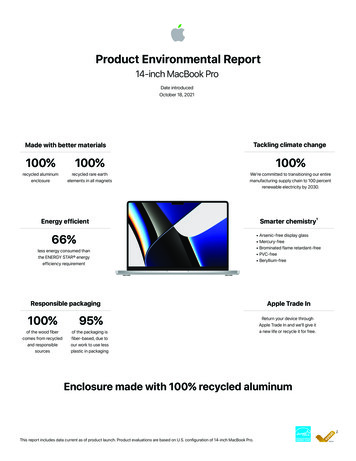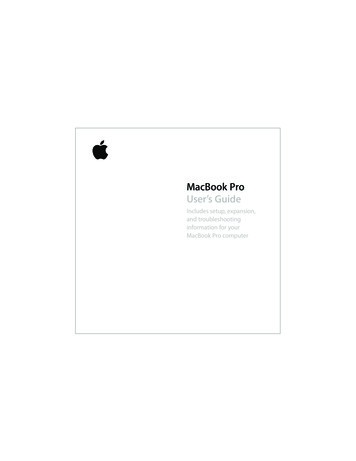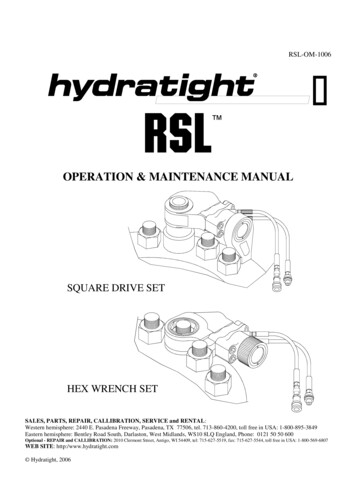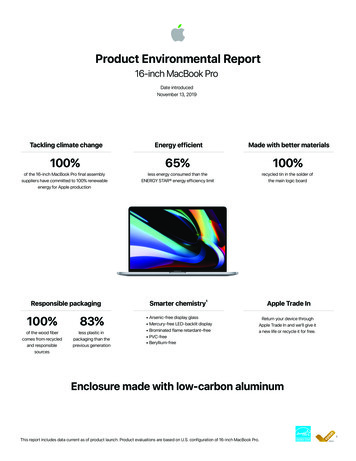
Transcription
Product Environmental Report14-inch MacBook ProDate introducedOctober 18, 2021Tackling climate changeMade with better materials100%100%100%recycled aluminumenclosurerecycled rare earthelements in all magnetsWe’re committed to transitioning our entiremanufacturing supply chain to 100 percentrenewable electricity by 2030.Energy efficientSmarter chemistry¹66% Arsenic-free display glass Mercury-free Brominated flame retardant–free PVC-free Beryllium-freeless energy consumed thanthe ENERGY STAR energyefficiency requirementResponsible packaging100%of the wood fibercomes from recycledand responsiblesources95%of the packaging isfiber-based, due toour work to use lessplastic in packagingApple Trade InReturn your device throughApple Trade In and we’ll give ita new life or recycle it for free.Enclosure made with 100% recycled aluminum2This report includes data current as of product launch. Product evaluations are based on U.S. configuration of 14-inch MacBook Pro.
Taking responsibility forour products at every stageWe take responsibility for our products throughout their life cycles—including the materialsthey are made of, the people who assemble them, and how they are recycled at end of life.And we focus on the areas where we can make the biggest difference for our planet: reducingour impact on climate change, conserving important resources, and using safer materials.We sell millions of products.So making even smalladjustments can have ameaningful impact.SourceMaterialsRecoverMake14-inch MacBook Prolife cycle271 kg carbonemissions3Packageand ShipUseCarbon footprintWe continue to make progress in reducing Apple’s contribution to climate change—by focusingon making energy-efficient products with renewable or recycled materials and with renewableenergy. Suppliers’ use of renewable energy through our Supplier Clean Energy Program helpedreduce emissions from production of the 14-inch MacBook Pro. And the more efficiently designedApple silicon enabled performance improvements without increasing the carbon footprint of themain logic board. Overall, with design changes including the larger 14-inch display size, totalproduct emissions increased by about 8 percent compared to the previous-generation 13-inchMacBook Pro with four Thunderbolt 3 ports.4 Apple is committed to using carbon life cycleassessments to identify opportunities to drive down product greenhouse gas emissions.214-inch MacBook Pro14-inch MacBook Prolife cycle carbon emissions72%Production5%Transport22%Use 1%End-of-life processingProduct Environmental Report
Source MaterialsMakeSourceMaterialsProductlife cycleRecoverFirst Mac notebook made with 100 percent recycled rare earthelements in all magnets.Packageand ShipTo conserve important resources, we work to reduce the material we use and aim to one daysource only recycled or renewable materials in our products. And as we make this transition,we remain committed to the responsible sourcing of primary materials. We map many materials,some to the mineral source, and establish the strictest standards for smelters and refiners.Apple also requires 100 percent of identified tin, tantalum, tungsten, gold, cobalt, and lithiumsmelters and refiners to participate in third-party audits.5 We’re proud to be recognized as aworldwide leader in the responsible sourcing of minerals in our products. Our product designsalso consider the safety of those who make, use, and recycle our products, restricting the useof hundreds of harmful substances. Our standards go beyond what’s required by law to protectpeople and the environment.UseAluminumPlasticTinRare earth elementsApple created an aluminum alloymade of 100 percent certifiedrecycled aluminum, which weuse for the enclosure of the14-inch MacBook Pro.6 Thisalloy delivers the same strength,durability, and flawless finish—without mining any new bauxite(aluminum ore) from the earth.We’re transitioning from fossilfuel–based plastics to thosemade from renewable or recycledsources. For the 14-inchMacBook Pro, we use 35 percentor more recycled plastic inseven components.We use 100 percent recycledtin in the solder of the mainlogic board.We use 100 percent recycledrare earth elements in allmagnets, representing 98 percentof the total rare earth elementsin the device—a first for aMac notebook.Smarter chemistryThe 14-inch MacBook Pro is free of harmful substances like beryllium, brominated flameretardants, PVC, phthalates, arsenic in the display glass, and mercury.1 And 100 percent of thematerials in the 14-inch MacBook Pro are covered by our Regulated Substances Specification.We go beyond what’s required by aiming to understand the non-regulated substances in everypart of every product—an effort that requires an industry-leading level of transparency throughthe entire supply chain. We consistently identify the makeup of over 75 percent by mass ofMac devices.314-inch MacBook ProProduct Environmental Report
MakeMakeSourceMaterialsProductlife cycleRecoverPackageand ShipUseThe Apple Supplier Code of Conduct sets strict standards forthe protection of people in our supply chain and the planet thatwe all share. Every year, we assess our suppliers’ performancein upholding the standards required by our Code.We work closely with our suppliers to provide safe and healthy workplaces where peopleare treated with dignity and respect, and to reduce suppliers’ environmental impact. Ourrequirements apply across our supply chain, and include the responsible sourcing of materials.From the strong foundation set by our Code, we go further—from helping suppliers transitionto renewable energy, to providing educational opportunities for their employees, to supportingfinal assembly suppliers in reducing waste.Supplier energy useZero Waste to LandfillGreener chemicalsAll established 14-inch MacBook Profinal assembly supplier sites useAll established 14-inch MacBook Profinal assembly supplier sites do notgenerate any waste sent to landfill.8All 14-inch MacBook Pro final assemblysupplier sites are transitioning to100 percent renewable energy forApple production.safer cleaners and degreasers intheir manufacturing processes, asdetermined by methodologies likethe GreenScreen assessment.7414-inch MacBook ProProduct Environmental Report
Package and ShipMakeSourceMaterialsProductlife cycleRecoverPackageand ShipUseThe 14-inch MacBook Pro packaging is made with 100 percentrecycled and responsibly sourced wood fiber.To improve our packaging, we are working to eliminate plastics, increase recycled content, anduse less packaging overall. All of the wood fiber in our packaging is either recycled or comesfrom responsibly managed forests.9 And we have protected or created enough responsiblymanaged forests to cover all the virgin wood fiber we use in our packaging.10 This ensuresworking forests are able to regrow and continue to clean our air and purify our water.95%of the packaging11is fiber-based, due toour work to use lessplastic in packaging51%recycled content infiber packaging100%of the virgin woodfiber in the packagingcomes from responsiblymanaged forests9514-inch MacBook ProProduct Environmental Report
UseMakeSourceMaterialsProductlife cycleRecoverPackageand ShipUseThe 14-inch MacBook Pro uses 66 percent less energy than therequirement for ENERGY STAR.12We design our products to be energy efficient, long lasting, and safe. The 14-inch MacBook Prouses software and power-efficient components that intelligently manage power consumption.We also run our own Reliability and Environmental Testing Labs, where our products go throughrigorous testing before they leave our doors. Our support continues throughout each product’slife cycle, with regular software updates to keep devices current and a network of authorizedrepair professionals to service them, if necessary.ENERGY STARrequirement14-inch MacBook ProEnergy consumption of ENERGY STAR–rated productsApple devices consistently rank among the high-performing products ratedby ENERGY STAR, which sets specifications that typically reflect the 25 percentmost energy-efficient devices on the market. The 14-inch MacBook Proconsumes 66 percent less energy than the requirement for ENERGY STAR.12kWhUses less energykWhUses more energyDesigned to lastTo ensure durability, we assessedthe 14-inch MacBook Pro in ourReliability Testing Lab, usingrigorous testing methods thatsimulate customers’ experiences.Made with smarterchemistryWe apply rigorous controls formaterials users touch—all basedon recommendations fromtoxicologists and dermatologists.614-inch MacBook ProProduct Environmental Report
RecoverMakeSourceMaterialsProductlife cycleRecoverPackageand ShipUseReturn your product with Apple Trade In and we’ll ensure it hasa long life or recycle it for free.When products are used longer, fewer resources are extracted from the earth. That’s why welaunched Apple Trade In—it offers customers a seamless way to return their old devices andaccessories to Apple. Eligible devices can be traded in for credit or an Apple Store Gift Card,while accessories and other devices can be recycled for free.13 We also offer and participatein product take-back and recycling collection programs for 99 percent of the countries wherewe sell products—and we hold our recyclers to high standards. Our efforts to keep harmfulsubstances out of our products also mean our materials are safer to recover and reuse.Apple Trade InFor more information on how to recycleyour products at end of life, visit:apple.com/trade-in714-inch MacBook ProProduct Environmental Report
DefinitionsRecycled materials: Recycling makes better useof finite resources by sourcing from recovered ratherthan mined materials. Recycled content claims formaterials used in our products have been verifiedby an independent third party to a recycled contentstandard that conforms to ISO 14021.Bio-based plastics: Bio-based plastics are madefrom biological sources rather than from fossil-fuelsources. Bio-based plastics allow us to reducereliance on fossil fuels.Renewable materials: We define bio-materials asthose that can be regenerated in a human lifespan,like paper fibers or sugarcane. Bio-materials canhelp us use fewer finite resources. But even thoughbio-materials have the ability to regrow, they are notalways managed responsibly. Renewable materialsare a type of bio-material managed in a way thatenables continuous production without depletingearth’s resources. That’s why we focus on sourcesthat are certified for their management practices.EndnotesApple addresses this uncertainty by developingdetailed process-based environmental modelswith Apple-specific parameters. For the remainingelements of Apple’s carbon footprint, we rely onindustry average data and assumptions. Calculationincludes emissions for the following life cycle phasescontributing to Global Warming Potential (GWP100 years) in CO2 equivalency factors (CO2e): Production: Includes the extraction, production,and transportation of raw materials, as well as themanufacture, transport, and assembly of all partsand product packaging. Transport: Includes air and sea transportation ofthe finished product and its associated packagingfrom manufacturing site to regional distributionhubs. Transport of products from distribution hubsto end customers is modeled using averagedistances based on regional geography.Supplier Clean Energy Program: Since the electricityused to make our products is the largest contributorto our overall carbon footprint, we’re helping oursuppliers become more energy efficient and transitionto new renewable energy sources. We’re committedto transitioning our entire manufacturing supply chainto 100 percent renewable electricity by 2030. Use: Apple assumes a three- or four-year periodfor power use by first owners based on the producttype. Product use scenarios are based on historicalcustomer use data for similar products. Energy use issimulated in various ways; for example, by modelingdaily battery drain or through performing activitieslike movie and music playback. Geographicdifferences in the power grid mix have beenaccounted for at a regional level.Carbon footprint: Estimated emissions are calculatedin accordance with guidelines and requirements asspecified by ISO 14040 and ISO 14044. There isinherent uncertainty in modeling carbon emissionsdue primarily to data limitations. For the topcomponent contributors to Apple’s carbon emissions, End-of-life processing: Includes transportationfrom collection hubs to recycling centers andthe energy used in mechanical separation andshredding of parts. For more information on thecarbon footprint, visit apple.com/environment/answers.1 Appledefines its restrictions on harmful substances, including definitions for what Apple considers to be “free of,”in the Apple Regulated Substances Specification. Every Apple product is free of PVC and phthalates with theexception of AC power cords in India, Thailand (for 2-prong AC power cords), and South Korea, where we continueto seek government approval for our PVC and phthalates replacement. Apple products comply with the EuropeanUnion Directive 2011/65/EU and its amendments, including exemptions for the use of lead such as high-temperaturesolder. Apple is working to phase out the use of these exempted substances where technically possible.2 The14-inch MacBook Pro achieved a Gold rating in the United States and Canada, in accordance with IEEE 1680.1or UL 110, and is listed as such on the Electronic Product Environmental Assessment Tool (EPEAT) Registry. EPEATregisters computers, displays, and mobile phones based on environmental requirements in these standards. Formore information, visit www.epeat.net.3 Greenhousegas emissions were calculated using a life cycle assessment methodology in accordance with ISO14040 and 14044 standards and based on the 14-inch MacBook Pro standard configuration with 512GB storage. Weoften update our carbon models to leverage new information. As a result, our estimate for the carbon footprint of theprevious generation—MacBook Pro (13-inch, 2020, Four Thunderbolt 3 ports) standard configuration with 512GBstorage configuration—increased from 251 kg CO2e (as published in its Product Environmental Report) to252 kg CO2e.Carbon footprint14-inch MacBook Pro (2021)13-inch MacBook Pro with four Thunderbolt 3 ports (2020)Apple M1 Pro with 8-core CPU and 14-core GPU, with 512GB storage271 kg CO2eQuad-Core Intel Processor with 512GB Storage252 kg CO2eApple M1 Pro with 10-core CPU and 16-core GPU, with 1TB storage307 kg CO2eQuad-Core Intel Processor with 1TB Storage300 kg CO2e814-inch MacBook ProProduct Environmental Report
Endnotes4 TheMacBook Pro (13-inch, 2020, Four Thunderbolt 3 ports) was used for comparison as the most recentlyreleased and similar device. Preproduction 14-inch MacBook Pro standard configuration with 512GB storage wascompared to shipping MacBook Pro (13-inch, 2020, Four Thunderbolt 3 ports) standard configuration with 512GBstorage configuration since these are the two lowest storage configurations offered.5 Wemap materials in our supply chain and publish a list of identified tin, tantalum, tungsten, and gold (3TG), cobaltand lithium smelters and refiners in our supply chain. Third-party assessments seek to confirm sourcing practicesand are part of our responsible sourcing program. In addition, our efforts consider a broad range of risks, includingsocial, environmental, human rights, and governance risks.6Recycled material claim applies to the enclosure and is based on auditing done by UL LLC.7 Chemicalsthat meet GreenScreen benchmark 3 or 4 or other equivalent methodologies like U.S. EPA SaferChoice are considered safer and preferred for use. GreenScreen is a comprehensive hazard assessment tool thatevaluates substances against 18 different criteria. For more information, visit www.greenscreenchemicals.org.8 Allestablished final assembly supplier sites—or those that have been Apple suppliers for more than one year—for 14-inch MacBook Pro are third-party certified as Zero Waste by UL LLC (UL 2799 Standard). UL requires atleast 90 percent diversion through methods other than waste to energy to achieve Zero Waste to Landfill (Silver90–94 percent, Gold 95–99 percent, and Platinum 100 percent) designations.9 Responsiblesourcing of wood fiber is defined in Apple’s Sustainable Fiber Specification. We consider wood fibersto include bamboo.10 Formore information about our work to protect and create responsibly managed forests, please read ourEnvironmental Progress Report.11 Breakdownof U.S. retail packaging by weight. Select non-plastic, non-fiber materials excluded.12 Energyconsumption and energy efficiency values are based on the ENERGY STAR Program Requirementsfor Computers, including the max energy allowance for 14-inch MacBook Pro. For more information, visitwww.energystar.gov. ENERGY STAR and the ENERGY STAR mark are registered trademarks owned by theU.S. Environmental Protection Agency.The 14-inch MacBook Pro is tested with a fully charged battery and powered by the 67W USB-C Power Adapterwith the USB-C to MagSafe 3 Cable (2m). Off: Lowest power mode of the system. System is shut down. Sleep: Low power state that is entered automatically after 10 minutes of inactivity (default), or by selecting Sleepfrom the Apple menu. Wake for network access enabled. Idle—Display on: System is on and has completed loading macOS. Display brightness was set as defined byENERGY STAR Program Requirements for Computers and Auto-Brightness was turned off. Connected to Wi-Fi. Power adapter, no-load: Condition in which the 67W USB-C Power Adapter with the USB-C to MagSafe 3 Cable(2m) is connected to AC power, but not connected to the system. Power adapter efficiency: Average of the 67W USB-C Power Adapter with the USB-C to MagSafe 3 Cable (2m)measured efficiency when tested at 100 percent, 75 percent, 50 percent, and 25 percent of the power adapter’srated output current.Power consumption for 14-inch MacBook 8W0.30WIdle—Display on4.19W4.16W4.34WPower adapter, no-load0.04W0.04W0.05WPower adapter efficiency89.5%89.9%89.4%13 Trade-invalues vary based on the condition, year, and configuration of your trade-in device, and may also varybetween online and in-store trade-in. You must be at least 18 years old. In-store trade-in requires presentation ofa valid, government-issued photo ID (local law may require saving this information). Additional terms from Appleor Apple’s trade-in partners may apply. 2021 Apple Inc. All rights reserved. Apple and the Apple logo are trademarks of Apple Inc., registered in the U.S.and other countries. ENERGY STAR and the ENERGY STAR mark are registered trademarks owned by the U.S.Environmental Protection Agency. Other product and company names mentioned herein may be trademarks oftheir respective companies.914-inch MacBook ProProduct Environmental Report
All established 14-inch MacBook Pro final assembly supplier sites use safer cleaners and degreasers in their manufacturing processes, as determined by methodologies like the GreenScreen assessment. 7. Zero Waste to Landfill . All established 14-inch MacBook Pro final assembly supplie










